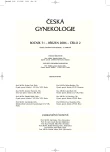Embryo Quality Evaluation According to the Speed of the first Cleavage after Conventional IVF
Authors:
J. Březinová 1; M. Svobodová 1; I. Oborná 1; H. Fingerová 1; J. Dostál 1; M. Kršková 2
Authors‘ workplace:
Centrum asistované reprodukce, Porodnicko-gynekologická klinika FN a LF UP, Olomouc
přednosta prof. MUDr. M. Kudela, CSc.
1; Centrum výpočetní techniky UP Olomouc, ředitel RNDr. F. Zedník
2
Published in:
Ceska Gynekol 2006; 71(2): 105-110
Category:
Original Article
Overview
Objective:
To evaluate morphological parametres of embryos obtained in the process of conventional IVF.
Design:
A prospective study.
Setting:
Centre of Assisted Reproduction, Dept. of Obstetrics and Gynecology, Palacký University Medical School, Olomouc.
Methods:
In the present study 549 embryos developing after conventional IVF in the period of 2001-2004 were evaluated. The beginning of the mitotic cleavage was assessed within the interval of 24 – 27 hours after insemination. The embryos were divided into three groups according to the speed of their divisionas early cleavage (EC) embryos, where two blastomeres were present at the time of assessment, break down pronuclei stage (BDPN) where the pronuclei had already disappeared, and pronuclei (PN) embryos, where both pronuclei were still present. In these groups the degree of fragmentation was evaluated on day two of cultivation and embryos were divided into four categories as: A – with regular blastomeres, without fragmentation, B - with irregular blastomeres or with fragmentation below 30%, C - with fragmentation 30-50%, D - with fragmentation above 50%. The speed of further cleavage and average number of blastomeres were evaluated on days two and three of cultivation. Statistical analysis was preformed in the Palacký University Computer Centre. The chi-square test and t test for independent samples were used.
Results:
EC embryos were found in 45.5%, BDPN in 33.5% and PN in 21.0%. EC embryos were less fragmented (p = 0.000), had more blastomeres at the time of evaluation (p = 0.000) and their speed of cleavage was faster (p = 0.000). The cleavage of EC embryos was faster in comparisson with the PN group (p = 0.000), but there were no significant differences between the EC and BDPN groups on day two of cultivation. On day three significant difference was found also between the EC and BDPN groups (p = 0.000).
Conclusion:
The speed of the first cell cleavage is a useful additional criterion for the embryo selection for ET. EC embryos usually have better morphology and more blastomeres that the BPDN and PN ones.
Key words:
„early cleavage“ embryos, embryo selection, embryo quality and viability, in vitro fertilization
Labels
Paediatric gynaecology Gynaecology and obstetrics Reproduction medicineArticle was published in
Czech Gynaecology

2006 Issue 2
Most read in this issue
- Embryo Quality Evaluation According to the Speed of the first Cleavage after Conventional IVF
- Serum Amyloid A as an Effective Marker for the Assessment of Surgical Trauma and Risk of Post-operative Complications
- Radical Parametrectomy in Women with Invasive Cervix Cancer after Previous Simple Hysterectomy
- Ursodeoxycholic Acid, S-adenosyl-L-methionine and their Combinations in the Treatment of Gestational Intrahepatic Cholestasis (ICP)
